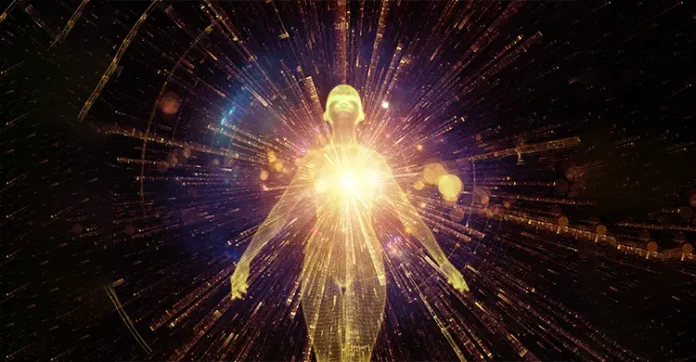The mahāvākyas are “the great sayings” of the Upanisạds as characterized by the Advaita school of Vedānta. There are four mahāvākyas associated with the four main Vedas. Our focus in this discussion will be on the mahāvākya “aham brahmāsmi” from the Brihadāraṇyaka Upaniṣad of the Yajur Veda.
“Ahaṃ” indicates the individual (jīvātmā) and“Brahma” the supreme consciousness (paramātmā); “asmi” means “I am”. So “ahaṃ brahmāsmi” means “i am the divine.” This concept encapsulates the notion that within every individual resides the ultimate reality, the all-pervading supreme consciousness. This is the essential teaching of the Bhagavadgītā. The entire text is presented in the form of a dialogue between Lord Kṛṣṇa and Arjuna, the warrior.
Question to Chitra ji:
How is the principle of Ahaṃ Brahmāsmi established in the 18 chapters of the Bhagavadgīta?
The first chapter presents the universal problem of suffering in the form of Arjuna’s dilemma. Overcome by grief, he surrenders to Lord Kṛṣṇa who, first and foremost, teaches him about the eternal nature of the ātmā or the Self in the second chapter. He explains that individuals suffer because they are not able to recognize their true selves because of spiritual ignorance or avidyā. One who realizes his true nature attains spiritual liberation or mokṣa. But for this, we need to purify and prepare the mind. From Chapters 3-5, Kṛṣṇa advice Arjuna to follow the path of karma yoga to gain knowledge of the Self. Thereafter, the sixth chapter is on meditation to realize our divine essence. Therefore, the first six chapters indicate “ahaṃ”.
From the 7th to the 12th chapter Lord Kṛṣṇa elaborates on his essential divine nature, Brahman. He explains that the world and all its beings are an expression of his own Self. In the 7th, 8th, and 9th chapters, he reveals that He is in all and everything is in Him. In the 10th chapter, he reveals his divine manifestations or his vibhūtis. In the 11th chapter Lord Kṛṣṇa reveals his divine cosmic form to Arjuna. Arjuna sees the entire universe contained in the limitless glorious form of the Lord. In the 12th chapter, Lord Kṛṣṇa talks elaborately about bhakti or devotion. Therefore, the second set of six chapters is about Brahma.
From the 13th chapter onwards, the Lord reveals that Ahaṃ and Brahma are essentially the same. In the 13th chapter, Lord Kṛṣṇa describes 20 values that we need to uncover to realize that our essential nature is Brahma. He describes our essential nature as kṣetrajña, the witness. This is not different from Brahma. In chapter 14, He talks about transcending the guṇas to realize our true Self. In the 15th chapter, He talks about the qualities required to recognize the Self.
In the 16th chapter, Lord Kṛṣṇa talks about divine and demonic qualities that are there in all. He advised that we need to enhance divine qualities to realize our true nature. In the 17th chapter, He elaborates on śraddhā as an essential part of our spiritual path. In the 18th chapter Lord Kṛṣṇa once again summarises the essential teachings and asks Arjuna to act according to his own svadharma and achieve self-realization. Therefore, the third set of six chapters is about “asmi.”
Question to Chitra ji:
What learnings do you offer to your students with the program Level-1?
Level 1 began with the chanting of the Gitā Dhyānam, nine verses in praise of the Gitā. Two verses from this were taught to students as an opening prayer for every session. An overview of the scripture was given and its relevance to each and every one of us. There was an introduction to the Saṃskṛtam alphabet and pronunciation.
The focus of this program is to teach the chanting of a few key verses from each chapter. In Level 1, a few ślokas from chapters 1- 6 were taught. At the same time, an overview of each chapter was explained, and a brief explanation of each verse. The emphasis of Volume 1 was to demonstrate to students that with some effort, we can all chant verses from the Gītā and apply them to our own lives. We can equip ourselves with dynamic everyday spirituality.
Link to the program: The Bhagavad Gita – Chanting with Chitra Ganesh Level 1
Question to Chitra ji:
Can you share what kind of ślokas are you picking for your upcoming program Level 2 based on chapters 7-12 based on the concept of Brahma?
This section of the text contains some very beautiful ślokas, where Lord Kṛṣṇa reveals his essential nature as the divine consciousness or Brahman. Ślokas contained in this section encourage us to experience divinity in every aspect of life.
For example in śloka 7.8, Kṛṣṇa says: “i am the taste in water, the light in the sun and the moon and the sacred syllable Oṃ in the Vedas, the sound in ether and the ability in man.” In śloka 10.20, Kṛṣna says: “I am the Self abiding in the hearts of all beings. I am the beginning, middle, and the end.”
So you see, there is a very beautiful thread of divinity that runs through these chapters. It is going to be very challenging to pick ślokas from this section of the text! This section culminates with an elaboration of bhakti yoga which is an important aspect of surrender.
Link to the program: The Bhagavad Gita Chanting with Chitra Ganesh Level 2
Question to Chitra ji:
What can we expect in Level 3 of the Bhagavad Gita Chanting?
Level 3 will be based on Chapters 13-18 of the Gītā. I hope that by then most students will be familiar with the pronunciation of Saṃskṛtam. There will certainly be a recap of the first two volumes so that students can gain a deeper understanding of the final six chapters of the text. Ślokas from this section will be carefully picked so that the essence of the Gītā is clear. At the end of this program, I hope that students will be able to chant the selected ślokas from every chapter that was taught and make that a part of their daily sādhanā. I also hope that students are able to appreciate that deep teachings from the Upaniṣads are conveyed in such simple ślokas and deepen their study of this beautiful text.
To Conclude,
hellomyyoga truly believes that the Bhagavad Gita is the timeless solution to all the challenges of modern life, suitable for people of all ages and phases. That’s why we are thrilled to introduce our self-paced Volume 1 program, as well as our paid Volume 2 program, making this ancient wisdom accessible to everyone. Join us on this incredible journey of self-discovery and find the answers you seek.
Read more blogs




It’s going to be a great study and understanding of Gita..